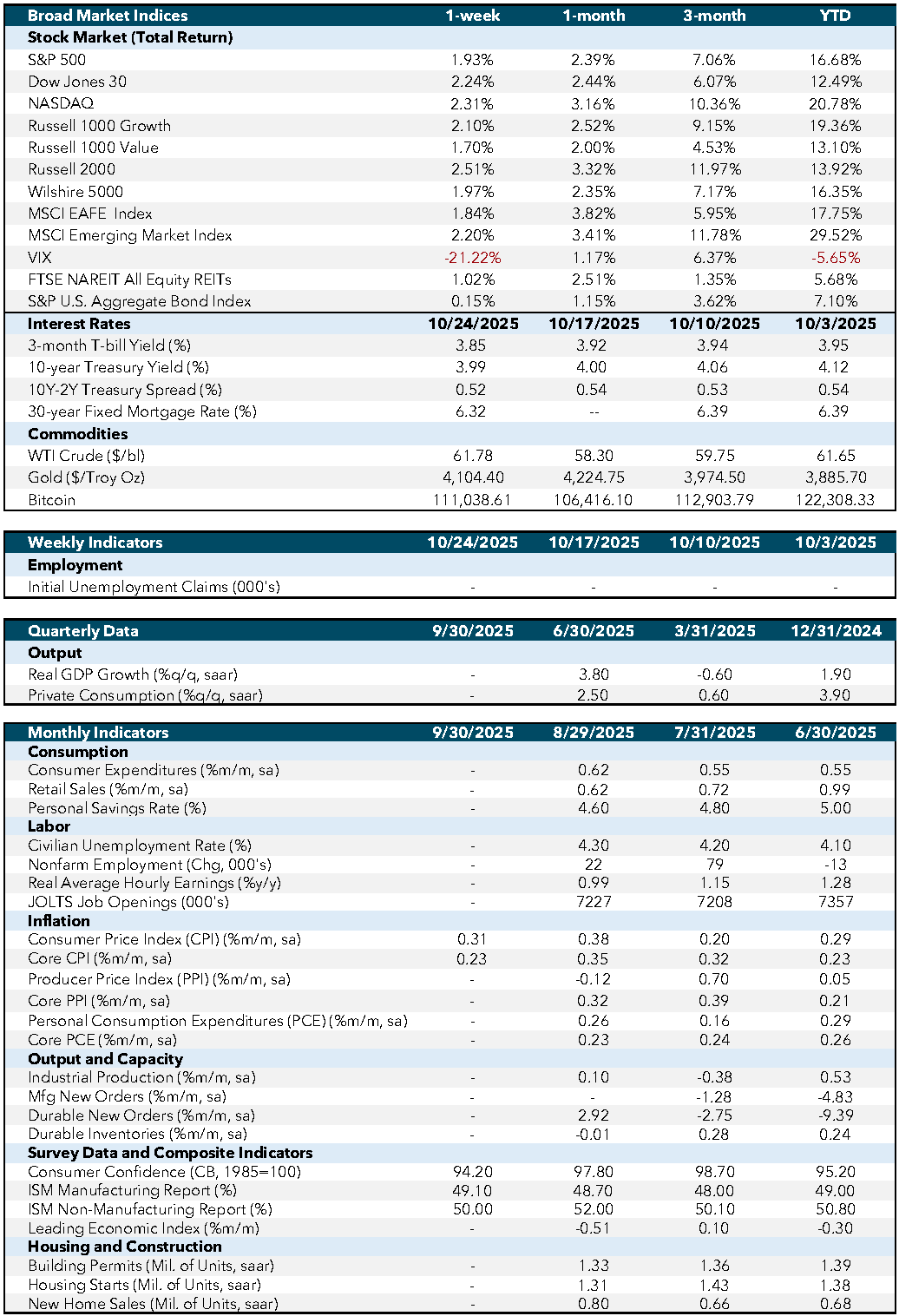Weekly Market Commentary
October 27th, 2025
Week in Review…
The most impactful release of the week was Friday’s Consumer Price Index (CPI) report. Both headline and core CPI came in slightly below expectations, with core CPI rising 0.2% versus 0.3% anticipated. Given the Fed’s preference for core inflation as a gauge of underlying price pressures, this softer print suggests inflation is sticky but trending lower, though still above the Fed’s target.
Another notable development was the 5-year Treasury Inflation-Protected Securities (TIPS) auction, which cleared at 1.182%, down from 1.650% in the prior auction. Interestingly, the 5-year breakeven inflation rate held near 2.42%, signaling markets expect lower real rates while inflation expectations remain anchored. The rationale is unclear — whether it reflects slowing growth, a flight to quality, or expectations of a lower Fed Funds rate as the Fed gravitates toward a lower neutral rate is yet to be determined. This dynamic likely explains why longer-dated yields, such as the 20-year Treasury auction, also came in below previous levels, reinforcing the notion that investors anticipate lower real rates despite static inflation expectations.
On the consumer side, the University of Michigan finalized October inflation expectations, showing 1-year expectations declining in line with forecasts, but 5-year expectations surprising to the upside at 3.9% versus 3.7% previously. This divergence suggests consumers anticipate higher inflation over the long run, even as near-term pressures ease.
Quick Hitters
- Housing: September existing home sales rose 1.5% month-over-month, in line with expectations. This uptick hints at resilient demand and suggests structurally lower rates could unlock further housing activity.
- Business Activity: Preliminary S&P Global Manufacturing and Services Purchasing Managers’ Indexes (PMIs) exceeded expectations and prior readings, signaling improving sentiment and underlying economic strength
- Consumer Sentiment: In contrast, the University of Michigan consumer sentiment index softened, highlighting concerns about household confidence. Given consumption’s critical role in gross domestic product (GDP), markets will monitor this trend.
Week Ahead…

With inflation easing and markets nearly certain of a rate cut, attention now shifts to what comes next. The week ahead brings the Federal Open Market Committee (FOMC) meeting into sharp focus, alongside a handful of consumer and demand indicators that could shape expectations for growth and policy.
The upcoming FOMC meeting will dominate market attention. Last week’s softer CPI print reinforced a picture of easing inflation pressures, but the Fed faces a limited data backdrop, particularly on labor market conditions. With few fresh indicators, policymakers may lean on secondary sources to gauge economic momentum. Despite this uncertainty, markets remain confident in a 25 bps rate cut, with odds holding near 98%.
Beyond the Fed, this week’s economic calendar is light due to the government shutdown, but several releases will help gauge consumer and demand trends. On Tuesday, the Conference Board Consumer Confidence Index will measure household optimism — a key driver of spending and growth. On Wednesday, the pending home sales report offers a forward-looking view of housing demand, signaling whether lower rates are unlocking buyer activity. Additionally, the weekly crude oil inventory report may draw more attention than usual. Last week broke a three-week streak of weaker-than-expected demand, and with limited macro data available, markets could use these figures as a proxy for broader economic activity.
Economic Indicators:
- CPI: Consumer Price Index measures the average change in prices paid by consumers for goods and services over time. Source: Bureau of Labor Statistics.
- Core CPI: Core Consumer Price Index excludes food and energy prices to provide a clearer picture of long-term inflation trends. Source: Bureau of Labor Statistics.
- PPI: Producer Price Index measures the average change in selling prices received by domestic producers for their output. Source: Bureau of Labor Statistics.
- Core PPI: Core Producer Price Index excludes food and energy prices to provide a clearer picture of long-term inflation trends. Source: Bureau of Labor Statistics.
- PCE: Personal Consumption Expenditures measure the average change in prices paid by consumers for goods and services. Source: Bureau of Economic Analysis.
- Core PCE: Core Personal Consumption Expenditures exclude food and energy prices to provide a clearer picture of long-term inflation trends. Source: Bureau of Economic Analysis.
- Industrial Production: Measures the output of the industrial sector, including manufacturing, mining, and utilities. Source: Federal Reserve.
- Mfg New Orders: Measures the value of new orders placed with manufacturers for durable and non-durable goods. Source: Census Bureau.
- Durable New Orders: Measures the value of new orders placed with manufacturers of durable goods. Source: Census Bureau.
- Durable Inventories: Measures the value of inventories held by manufacturers for durable goods. Source: Census Bureau.
- Consumer Confidence (CB, 1985=100): Measures the degree of optimism that consumers feel about the overall state of the economy and their personal financial situation. Source: Conference Board.
- ISM Manufacturing Report: Measures the economic health of the manufacturing sector based on surveys of purchasing managers. Source: Institute for Supply Management.
- ISM Non-Manufacturing Report: Measures the economic health of the non-manufacturing sector based on surveys of purchasing managers. Source: Institute for Supply Management.
- Leading Economic Index: Measures overall economic activity and predicts future economic trends. Source: Conference Board.
- Building Permits (Mil. of Units, saar): Measures the number of new residential building permits issued. Source: Census Bureau.
- Housing Starts (Mil. of Units, saar): Measures the number of new residential construction projects that have begun. Source: Census Bureau.
- New Home Sales (Mil. of Units, saar): Measures the number of newly constructed homes sold. Source: Census Bureau.
- SA: Seasonally adjusted.
- SAAR: Seasonally adjusted annual rate.
Market Indices & Indicators:
- S&P 500: A market-capitalization-weighted index of 500 leading publicly traded companies in the U.S., widely regarded as one of the best gauges of large U.S. stocks and the stock market overall.
- Dow Jones 30: Also known as the Dow Jones Industrial Average, it tracks the share price performance of 30 large, publicly traded U.S. companies, serving as a barometer of the stock market and economy.
- NASDAQ: The world’s first electronic stock exchange, primarily listing technology giants and operating 29 markets globally.
- Russell 1000 Growth: Measures the performance of large-cap growth segment of the U.S. equity universe, including companies with higher price-to-book ratios and growth metrics.
- Russell 1000 Value: Measures the performance of large-cap value segment of the U.S. equity universe, including companies with lower price-to-book ratios and growth metrics.
- Russell 2000: A market index composed of 2,000 small-cap companies, widely used as a benchmark for small-cap mutual funds.
- Wilshire 5000: A market-capitalization-weighted index capturing the performance of all American stocks actively traded in the U.S., representing the broadest measure of the U.S. stock market.
- MSCI EAFE Index: An equity index capturing large and mid-cap representation across developed markets countries around the world, excluding the U.S. and Canada.
- MSCI Emerging Market Index: Captures large and mid-cap representation across emerging markets countries, covering approximately 85% of the free float-adjusted market capitalization in each country.
- VIX: The CBOE Volatility Index measures the market’s expectations for volatility over the coming 30 days, often referred to as the “fear gauge.”
- FTSE NAREIT All Equity REITs: Measures the performance of all publicly traded equity real estate investment trusts (REITs) listed in the U.S., excluding mortgage REITs.
- S&P U.S. Aggregate Bond Index: Represents the performance of the U.S. investment-grade bond market, including government, corporate, mortgage-backed, and asset-backed securities.
- 3-Month T-bill Yield (%): The yield on U.S. Treasury bills with a maturity of three months, reflecting short-term interest rates.
- 10-Year Treasury Yield (%): The yield on U.S. Treasury bonds with a maturity of ten years, reflecting long-term interest rates.
- 10Y-2Y Treasury Spread (%): The difference between the yields on 10-year and 2-year U.S. Treasury bonds, often used as an indicator of economic expectations.
- WTI Crude ($/bl): The price per barrel of West Texas Intermediate crude oil, a benchmark for U.S. oil prices.
- Gold ($/Troy Oz): The price per troy ounce of gold, a standard measure for gold prices.
- Bitcoin: A decentralized digital currency without a central bank or single administrator, which can be sent from user to user on the peer-to-peer bitcoin network.
This content was developed by Cambridge from sources believed to be reliable. This content is provided for informational purposes only and should not be construed or acted upon as individualized investment advice. It should not be considered a recommendation or solicitation. Information is subject to change. Any forward-looking statements are based on assumptions, may not materialize, and are subject to revision without notice. The information in this material is not intended as tax or legal advice.
Investing involves risk. Depending on the different types of investments there may be varying degrees of risk. Socially responsible investing does not guarantee any amount of success. Clients and prospective clients should be prepared to bear investment loss including loss of original principal. Indices mentioned are unmanaged and cannot be invested into directly. Past performance is not a guarantee of future results.
The Dow Jones Industrial Average (DJIA) is a price-weighted index composed of 30 widely traded blue-chip U.S. common stocks. The S&P 500 is a market-cap weighted index composed of the common stocks of 500 leading companies in leading industries of the U.S. economy. The NASDAQ Composite Index is a market-value weighted index of all common stocks listed on the NASDAQ stock exchange.
Securities offered through Cambridge Investment Research, Inc., a broker-dealer, member FINRA/SIPC, and investment advisory services offered through Cambridge Investment Research Advisors, Inc., a Registered Investment Adviser. Both are wholly-owned subsidiaries of Cambridge Investment Group, Inc. V.CIR.1025-3944

